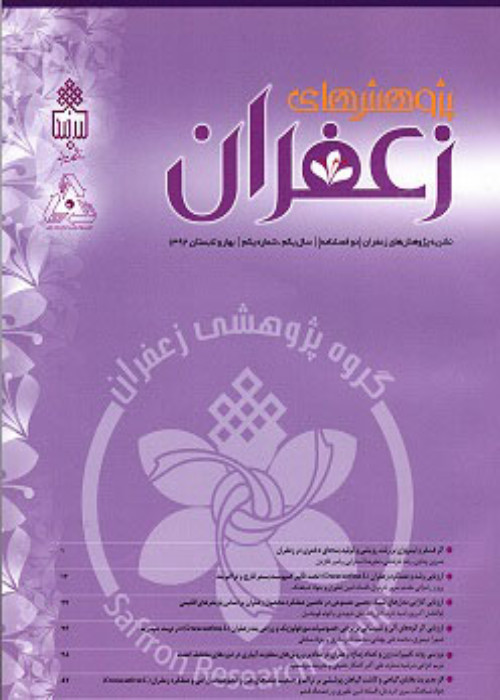The effect of maternal corm weight and planting depth on flower yield and daughter corm of saffron (Crocus sativus L.) in Sari Plain
Author(s):
Article Type:
Research/Original Article (بدون رتبه معتبر)
Abstract:
Introduction
Saffron (Crocus sativus L.) is a perennial plant and geophyte, triploid and belongs to the family of Iridaceae. One of the most important factors that has a great effect on the final performance is the size of corm. Therefore, in order to obtain large corms, it is very important to create suitable environmental and management conditions. Determining the appropriate planting depth is also one of the ways to improve the performance of saffron per unit area. The purpose of this research is to investigate different sizes of saffron corms and planting depth on the yield of daughter corms of different sizes, flower and dry stigma of saffron in the conditions of Sari plain. Materials and Methods
The present study was conducted to investigate the effect of different weights of mother corms and different planting depths on corm production and saffron yield in a factorial experiment based on a randomized complete block design and in three replications in the research farm of Sari Agricultural Sciences and Natural Resources University during the growing season 2019-2020. The experimental treatments included three corm sizes: weight group; small 4±2 g, medium 10±2 g and large 15±2 g and two planting depths of 10 and 15 cm. The studied traits included: the number and yield of daughter corms, the number of buds, the number and yield of flowers and the yield of dry saffron stigma. Data analysis and graphs were done using SAS 9.0, Excel 2016 and Sigma Plot 12.0 software, respectively, and comparison of average data with the help of LSD test at 5% probability level. Results and Discussion
The trend of temperature changes as well as the investigation of the phenological events of saffron in the study area showed that at the beginning of the growing season and in the middle of autumn, the emergence of leaves is observed along with the emergence of reproductive organs (fig.1); This factor is probably related to the temperature fluctuations at the beginning of the plant's growing season (Table 1), and on the other hand, due to the allocation of the stock of mother corms to the leaves, it ultimately reduces flowering and stigma yield. The results showed that the highest number of daughter tubers and the total yield of daughter corms with 485 corm/ m2 and 2435.3 g/m2, respectively, were related to the treatment of large mother corm; however, no significant difference was observed between these traits in two planting depths for large corm (Table 2). The lowest total yield of daughter corms related to the treatment of planting small mother corms at a depth of 10 cm was equal to 1488.7 corm/ m-2. The average weight of daughter corms produced in this experiment (between 4.72 and 5.37 g) was about twice more than the amount produced in dry areas (Moallem Banhangi et al. 2019, Moein Rad et al., 2018. Razavian et al. 2019, Sharifi et al. 2021 & Esmi et al. 2019). Conclusion
According to the results obtained in this experiment and also taking into account the texture of the field soil under test, the depth of 15 cm is more suitable than the depth of 10 cm for the production of corm with the desired size. But there is a possibility that in areas and lands with heavier soil, especially in the conditions of Mazandaran plain, which has abundant rainfall and poor drainage in some areas, shallower planting (10 cm deep) is better than deeper planting. It created more favorable conditions for root growth. Because the shallow planting depth, while creating drainage and better exit of excess water from the environment around the root and stem, provides a better growing environment for the growth of this plant. Therefore, according to the mentioned cases and the climatic features of the Sari plain, for better productivity of agricultural land in autumn and winter, saffron cultivation should be done annually and with priority to produce high-quality seeds and use these seeds in saffron-rich areas or conditions Aviation can be considered.Keywords:
Language:
Persian
Published:
Journal of Saffron Research, Volume:10 Issue: 2, 2022
Pages:
231 to 244
magiran.com/p2554458
دانلود و مطالعه متن این مقاله با یکی از روشهای زیر امکان پذیر است:
اشتراک شخصی
با عضویت و پرداخت آنلاین حق اشتراک یکساله به مبلغ 1,390,000ريال میتوانید 70 عنوان مطلب دانلود کنید!
اشتراک سازمانی
به کتابخانه دانشگاه یا محل کار خود پیشنهاد کنید تا اشتراک سازمانی این پایگاه را برای دسترسی نامحدود همه کاربران به متن مطالب تهیه نمایند!
توجه!
- حق عضویت دریافتی صرف حمایت از نشریات عضو و نگهداری، تکمیل و توسعه مگیران میشود.
- پرداخت حق اشتراک و دانلود مقالات اجازه بازنشر آن در سایر رسانههای چاپی و دیجیتال را به کاربر نمیدهد.
In order to view content subscription is required
Personal subscription
Subscribe magiran.com for 70 € euros via PayPal and download 70 articles during a year.
Organization subscription
Please contact us to subscribe your university or library for unlimited access!



